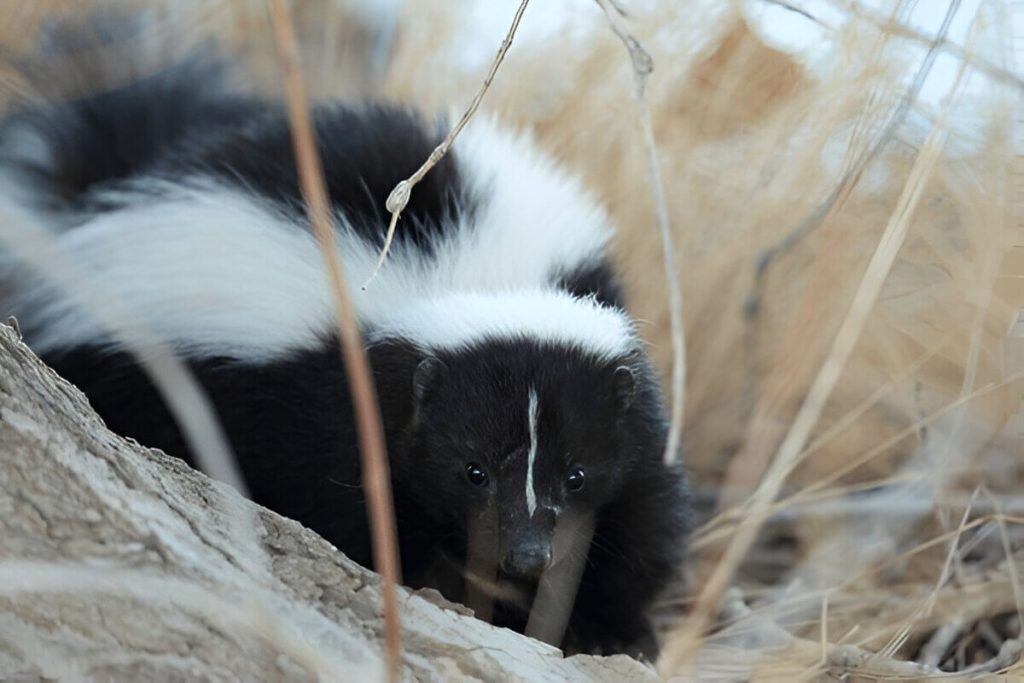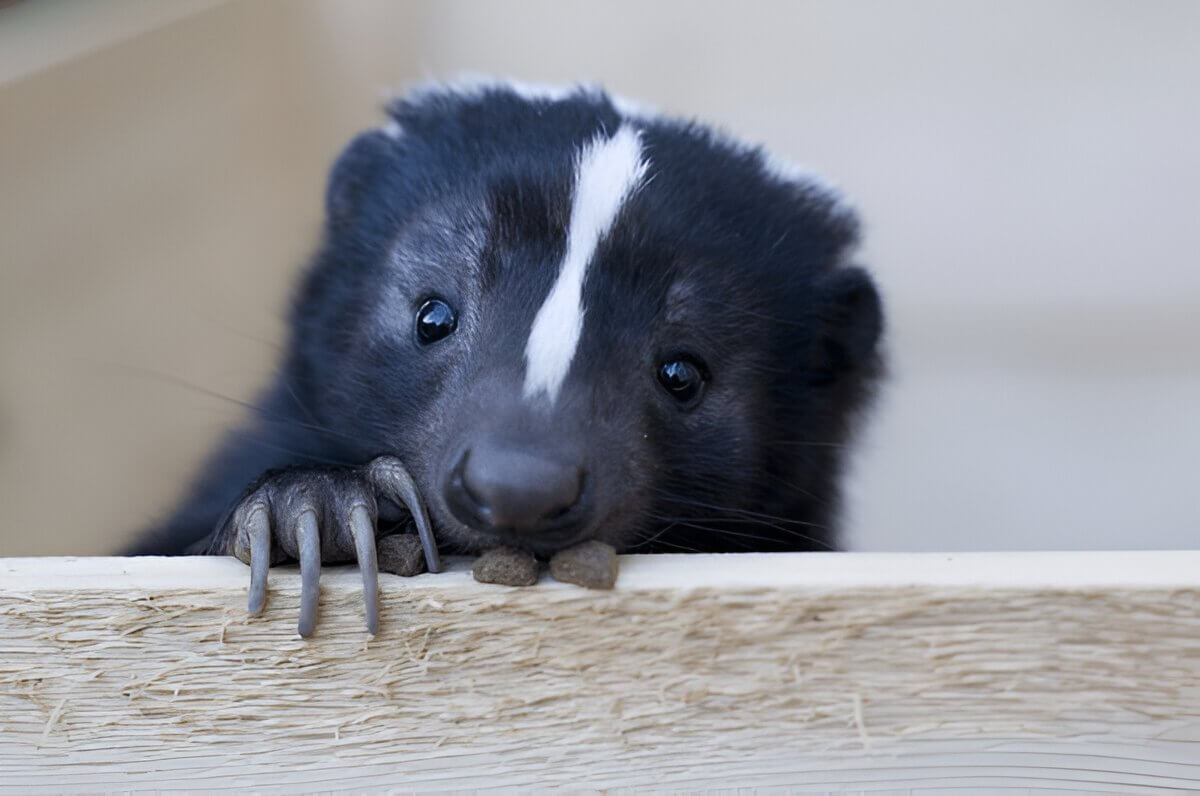Skunks, often recognized by their distinctive black and white stripes, are fascinating creatures with unique dietary habits that reflect their adaptability and resourcefulness. Understanding what skunks eat is crucial for appreciating their role in the ecosystem and managing any potential interactions with them.
Skunks are omnivorous animals, meaning they have a diverse diet that includes both plant and animal matter. This varied diet allows them to thrive in different environments. A typical skunk diet overview reveals that these creatures consume insects, small mammals, birds’ eggs, fruits, nuts, and even human waste when available. Insects such as beetles and grubs form a significant part of their diet during warmer months due to their abundance.
Understanding skunk feeding habits further highlights their opportunistic nature. Skunks tend to forage at night using their keen sense of smell to locate food sources. They are not picky eaters; instead, they adapt to the availability of food in their environment. This adaptability is essential for meeting skunk dietary needs throughout the year, especially during seasons when certain foods become scarce.
Skunks play an important ecological role by consuming various pests and contributing to seed dispersal through fruit consumption. By understanding what do skunks eat and recognizing the breadth of a skunk’s diet overview, we can better appreciate these often misunderstood animals while minimizing conflicts with them in our shared habitats.
The Omnivorous Nature of Skunks
Skunks are fascinating creatures, particularly when it comes to their dietary habits. As omnivorous animals, skunks boast a remarkably varied diet that allows them to thrive in diverse environments. Understanding what omnivores eat reveals the adaptability and resourcefulness of these creatures.
The varied diet of skunks includes both plant and animal matter, which they consume based on availability and seasonality. In the spring and summer months, skunks often feast on insects such as beetles, grasshoppers, and crickets, which provide a rich source of protein. They are also known to consume small mammals like mice or voles when the opportunity arises.
As autumn approaches, skunks shift their focus towards fruits and berries that are abundant during this time. Apples, grapes, and wild berries become a significant part of their diet as they prepare for the colder months ahead. Additionally, they may dig up roots or bulbs to supplement their nutritional intake.
In winter, when food is scarcer, skunks rely on stored body fat but continue to forage for whatever is available. This dietary diversity in skunks not only highlights their adaptability but also underscores the importance of understanding how different species manage survival across varying ecosystems.
By exploring the omnivorous nature of skunks further, we gain insight into the complex balance within natural habitats and how these adaptable animals contribute to ecological stability through their diverse eating habits.
A Closer Look at Natural Foods in a Skunk’s Diet

When exploring the natural diet of wild skunks, it’s fascinating to observe the diverse array of wild food sources these adaptable creatures rely on. Skunks are omnivores, meaning their diet includes both animal and plant-based foods, allowing them to thrive in various environments.
Insects and small animals form a significant part of the skunk’s diet. They often feast on insects such as beetles, grasshoppers, and crickets, which provide essential proteins and nutrients. Additionally, skunks are known to prey on small vertebrates like mice and frogs when available. This opportunistic feeding behavior plays a crucial role in controlling pest populations.
On the plant-based side of their diet, skunks consume a variety of fruits and vegetables depending on seasonal availability. Berries such as blackberries and raspberries are popular choices during summer months. In fall, they might turn to nuts or seeds as these become more abundant.
Understanding the natural diet of wild skunks highlights their role in maintaining ecological balance through both pest control and seed dispersal. By examining these dietary habits closely, we gain insight into how skunks contribute positively to their habitats while adapting seamlessly to changing food availabilities throughout the year.
Skunk Feeding Patterns Throughout the Seasons
Skunks, like many wildlife species, exhibit notable changes in their feeding patterns as the seasons shift. Understanding these seasonal diet changes in skunks provides insight into their adaptability and survival strategies.
During the warmer months of spring and summer, skunks have access to a rich variety of foods. Their diet primarily consists of insects such as beetles and grasshoppers, which are abundant during this time. Additionally, skunks take advantage of available fruits and berries, supplementing their diet with plant matter that offers essential nutrients.
As autumn approaches, skunks begin to prepare for the colder months by increasing their intake of high-fat foods. This preparation is crucial for building up fat reserves that will sustain them through winter when food is scarce. In this period, they may consume more rodents or small mammals if available.
Winter presents a challenge due to limited food resources; thus, the winter diets of skunks shift significantly. Skunks often rely on whatever they can scavenge or hunt during milder weather spells when they venture out from their dens. They may eat carrion or leftover human waste if accessible.
In summary, how seasons affect what skunks eat highlights their remarkable ability to adapt to changing environments by altering their dietary habits according to availability and nutritional needs throughout the year.
The Role of Human Environments in Shaping Skunk Diets
Skunks, known for their distinctive black and white markings and notorious scent, have become increasingly visible in urban areas. As cities expand into natural habitats, these adaptable creatures find themselves navigating human environments more frequently. This shift has a significant impact on their diets, as they start to consume more human food.
In urban areas, skunks often forage through garbage bins and compost piles, where they encounter a variety of human food items. These foods range from leftover fast-food to discarded fruits and vegetables. The availability of such resources can lead to skunks incorporating more processed foods into their diets than they would typically consume in the wild.
The impact of human environments on wildlife diets extends beyond just providing new food sources; it also influences the nutritional balance that these animals maintain. Skunks that rely heavily on human food may experience changes in health due to altered nutrient intake. Additionally, the presence of easily accessible food can affect skunk behavior and population dynamics within urban settings.
Understanding how skunks adapt their diets in response to urbanization is crucial for wildlife management and conservation efforts. By studying these patterns, we can better assess the ecological impacts of our expanding cities and develop strategies to mitigate negative effects on local wildlife populations.
Ensuring a Healthy Diet for Pet Skunks
When it comes to the dietary requirements for pet skunks, ensuring they receive a well-balanced and nutritious diet is essential for their overall health and well-being. Skunks, being omnivorous creatures, have specific nutritional needs that must be met to thrive in captivity. Understanding these needs is crucial for any responsible skunk owner.
Feeding pet skunks properly involves providing a varied diet that mimics what they would naturally consume in the wild. This includes a balance of proteins, fats, carbohydrates, vitamins, and minerals. A typical diet might consist of high-quality protein sources such as lean meats or specially formulated skunk food available commercially. In addition to proteins, it’s important to include fruits and vegetables in their meals to ensure they get the necessary vitamins and fiber.
The nutritional needs of captive wildlife like skunks also require careful attention to avoid obesity—a common issue due to overfeeding or improper diets. Regularly monitoring their weight and adjusting food portions accordingly can help maintain a healthy weight.
Additionally, consulting with a veterinarian who specializes in exotic pets can provide valuable guidance on creating an appropriate feeding regimen tailored to your pet skunk’s individual needs. By prioritizing proper nutrition and understanding the unique dietary requirements of pet skunks, owners can contribute significantly to their pets’ longevity and quality of life.
Conclusion- The Importance of Understanding What Skunks Eat for Coexistence and Conservation Efforts
Understanding what skunks eat is crucial for fostering coexistence and supporting conservation efforts. Skunks, often misunderstood due to their infamous defense mechanism, play a valuable role in ecosystems as both predators and scavengers. By consuming a variety of insects, small mammals, fruits, and vegetation, skunks help control pest populations and contribute to the balance of their habitats.
For those living in areas where skunks are common, knowing their dietary preferences can aid in developing strategies to minimize conflicts. For instance, securing garbage bins and avoiding leaving pet food outdoors can reduce the likelihood of attracting skunks into residential spaces. Additionally, understanding these dietary habits allows conservationists to better protect the natural resources that support skunk populations.
Efforts to conserve skunk habitats are enhanced by recognizing their role in biodiversity. As we continue to learn about what sustains these creatures, we can implement more effective measures to ensure they thrive alongside human communities. Ultimately, appreciating the ecological contributions of skunks not only benefits them but also enriches our environment as a whole.
